So you’ve finally decided to invest in intranet software. Perhaps, you’ve been struggling to get your employees to use the legacy intranet, but they would rather recreate the same documents over and over again than click on the Sharepoint icon once more. Or maybe you don’t have an intranet at all, and the sheer amount of newsletters, Teams messages and regular email updates haunts you at night.
Whatever the case might be, you’ve come to the right place! We’ve prepared a comprehensive guide on what intranet software is, how to choose a company intranet, and the kay intranet software benefits for your company. Make sure to read till the very end, as we’re going to provide you with a list of some of the best intranet vendors on the market.
Already made up your mind? Check out our step-by-step guide for launching an intranet platform 💡
What is Intranet Software
Since you’re reading this article, you must know already that intranet software is a piece of technology listed under the IT, HR, and internal comms departments that are designed to improve information flow, foster collaboration and a sense of community, and serve as a central hub for your employees.
Let our experts help you define your intranet needs!
What Does Intranet Software Do?
In the last decade, there has been a surge of intranet solutions, and it’s possible to divide all intranet software into two distinct categories:
- Legacy intranet software — The first one is legacy intranets, which includes tools like SharePoint that require a lot of IT support and serve primarily as knowledge repositories.
- Modern employee intranet software — The other one is modern or employee intranets, which places a bigger emphasis on social features and can be compared to a social media platform but in a professional set-up. Both intranet solutions are not mutually exclusive and, in fact, can drive greater productivity and satisfaction rates when they’re combined.
However, this article will explore the concept of modern intranet software and different vendors on the market. Undoubtedly, in order to make an informed decision, you need to study the intranet software market and compare it with what your company needs.
What are the Most Important Intranet Software Features
Top-down communication
One of the most important use cases for intranet software is to streamline the information flow within the company. Internal communications and HR professionals start looking for a new intranet solution when the technology that they have fails at delivering the right information at the right time.
Using a multichannel top-down communication solution is one of the best way to increase the reach and ensure your workforce always receives important updates. At the same time, targeting your communications to a group or even a number of individuals will help maxime the engagement with content.
When employees get relevant informaiton for their role right at their finger tips, it lowers the risks of digital fatigue, improve their poructivity levels and positvely affects employee experience.
Knowledge management
Unfortunately, ineffective knowledge management remains one of the biggest reasons for productivity losses. A study by SHRM suggests that Fortune 500 companies lose an estimated $31.5 billion annually by failing to share knowledge effectively. It all boils down to not being able to locate information in a company’s data base and having to recreate it from scratch. Not to mention that this approach comes with significant security risks!
To avoid that, you should look for intranet software that allows you to store and categorize all your files and documents in one place. Consider also providers with seamless AI-powered search that imitates ChatGPT and allows you to get access to the right document in seconds.

Employee directories
Employee directories are one of the many social features that improve collaboration and a sense of belonging in the workplace. Employee directories essentially display roles, contact information, and skills, making it easier to find the right colleagues. Having employee directories allows your employees to connect with colleagues across the company regardless of their location.
Integrations with existing tools and systems
Consolidation is fast becoming one of the biggest IT trends of the current decade. IT leaders are not looking only at investing in software that delivers multiple experiences, but also at unifying different tools under one tech ecosystem. Hence, integrations with different tools and ecosystems are growing in importance.
When looking for the best intranet software, consider checking integrations with Microsoft 365, Google Workspce, relevant talent acquisition and HR systems, as well as instant messaging tools, such as Slack and Teams.
Ease of use and ease of implementation
No CMS approach is still not widely accepted among different intranet providers, as many of them require extensive IT support when installing and managing software.
Having a solution with an easy UX will ensure that your new intranet platform is easy to set up, roll out to the entire business, and manage on a daily basis. Additionally, a user-friendly interface is the biggest key to intranet adoption and higher engagement rates with the tool among your workforce.
Communities for departmental and interest-based communication
As mentioned in the very beginning, intranet software is a social technology, which means your future solution should also support non-vertical communication and democratized content creation.
Groups and communities can perfectly close this gap as they offer your employees the possibility to create their own interest-based communities on the platform and create both professional and interest-based content.
By giving your employees a voice and a means of expressing it, you can increase trust in your organization and, thus, improve employee loyalty.
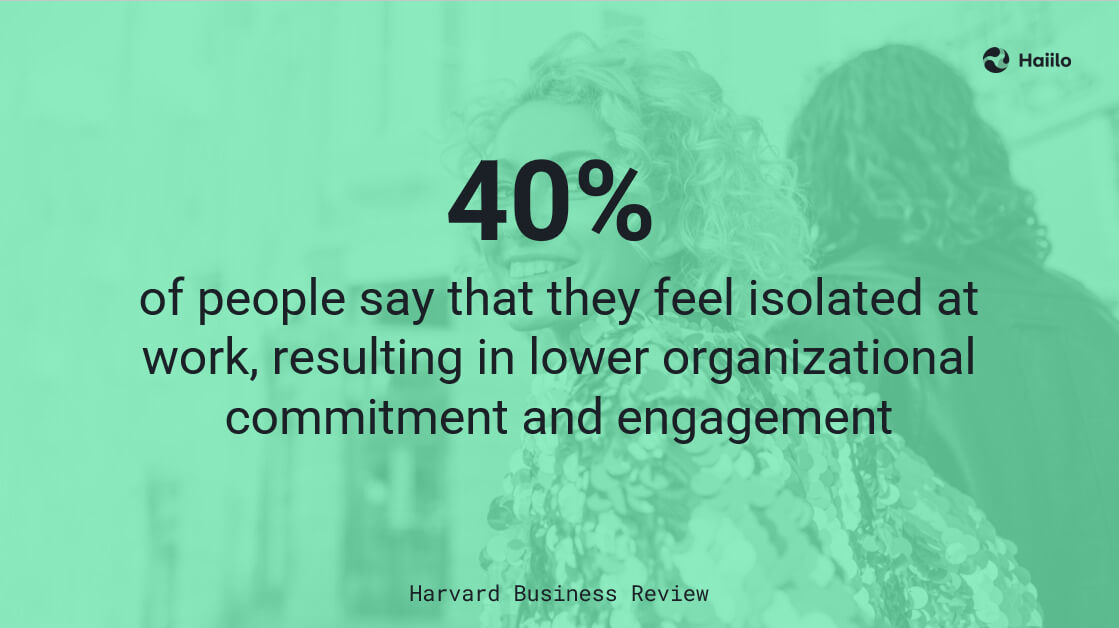
Event and calendar management
Events are just another step toward having all the right information on one platform. This feature allows you to view important dates, deadlines, and company events.
Security and compliance
As intranet software is one of the technologies widely used by the entire organization, you want to make sure no security risks are attached to it.
For that, look for intranet providers that meet the latest security requirements. GDPR, CCPA, IDPDP, as well as SOC-2 are among the certifications you want to keep in mind when choosing your intranet provider.
Analytics and reporting
In order to see whether the chosen intranet software lives up to standards, you need to regularly keep the pulse on your analytics.
Your analytics tool should be able to show your traditional metrics, such as the number of logins per day, content engagement, reach, and so on. However, you want to go even deeper and have impact analytics in your future intranet software.
Being able to assess how well each communication campaign performs, how well employees understand the updates, as well as gauge their (anonymous) feedback on them will help your tailor your communications startegy and prove the impact of your work to the C-level.
Integrated Ai tools
AI is all the rage, and granted, when implemented correctly, it can significantly boost productivity levels. Some AI use cases you might want to consider when looking for intranet software are:
- AI in content creation will help content creators be faster when publishing company updates
- AI in search to help streamline the process of looking for the relevant piece of information
- AI that summarizes previous posts and meetings to help new hires get up to speed or to help existing employees get back into the routine after a summer vacation, a parental leave, or a prolonged absence due to an illness
💡 Read on: Top 5 Ways AI Can Be Used to Embrace Internal Communications
7 Steps to Choose the Best Intranet Software
Now that we’ve outlined the most important intranet software features, it’s time to search for a perfect fit for you. The whole process of buying intranet software requires 7 key steps.
Re-evaluate your internal comms strategy
Let’s start with the basics. Your new intranet software should solve some very real internal comms problems. To find the best match, it might be helpful to review your internal comms strategy as well as the current business goals to know what you’re trying to improve with the new provider.
For example, the survey by PwC found that only 28% of employees feel truly connected to the company purpose. Unsurprisingly, this number translates into disengagement, poor performance and higher turnover rates within the organization. The right intranet software can help you connect your employes to purpose through content and communities, therefore, diminishing the effect misunderstanding and miscommunication might have on your company.

Some things to consider are:
- Increase strategy comprehension by X%
- Increase readership/engagement with content by X%
- Reach X% of employees with updates
- Increase the number of active intranet users by X%
When locking in your goals, make sure to outline how exactly you expect the new intranet software to improve the critical metrics. This will later help you get the team’s buy-in
📚Read on: Need to build a business case for the new intranet? Check out our article on how to communicate the ROI of the intranet software!
Define internal audiences
Every communicator has to understand their target group first. Establishing employee personas (in other words, your internal audiences) is a great way to get an understanding of what preferences your employees have when it comes to consuming company content.
Here are some questions to get you started:
- What channel(s) do your employees use the most for consuming company content?
- What is your workforce’s preferred content format? Is it written content? Is it podcast? Is it video?
- How many languages do you speak in your organization? – Are you English first? Spanish first? Do you use multiple languages depending on the location and/or the department?
- How many locations your company is present in? Does it require location-specific content (think safety regulations, national holidays, etc.)?
- What is the percentage of different generations and do they express any particular preferences toward technology?
- How many blue-collar vs white-collar workers do you have?
Alongside these questions, you could also think how much personalization you’d like to have. Once you know the answers to these questions, you’ll be able to identify the features your future solution should have.
💡Pro-tip: don’t hesitate to ask your employees! Create a simple survey with these questions to get a bird’s eye view over all the essential information.
Map out software requirements
You can now cross-reference the identified gaps from previous steps with the potential features you’d like to see in your software.
Revisit your overarching goals and write down how the intranet can help you in achieving those. If increasing strategy comprehension is on the list, consider investing in the intranet with a multichannel comms feature to ensure the optimal distribution of the news. To foster trust and a sense of belonging, you might want to look in the direction of a social intranet. Also, keep in mind the importance of quantitative and qualitative analytics, as more and more IC professionals need to prove the tangible impact internal comms have on the business.
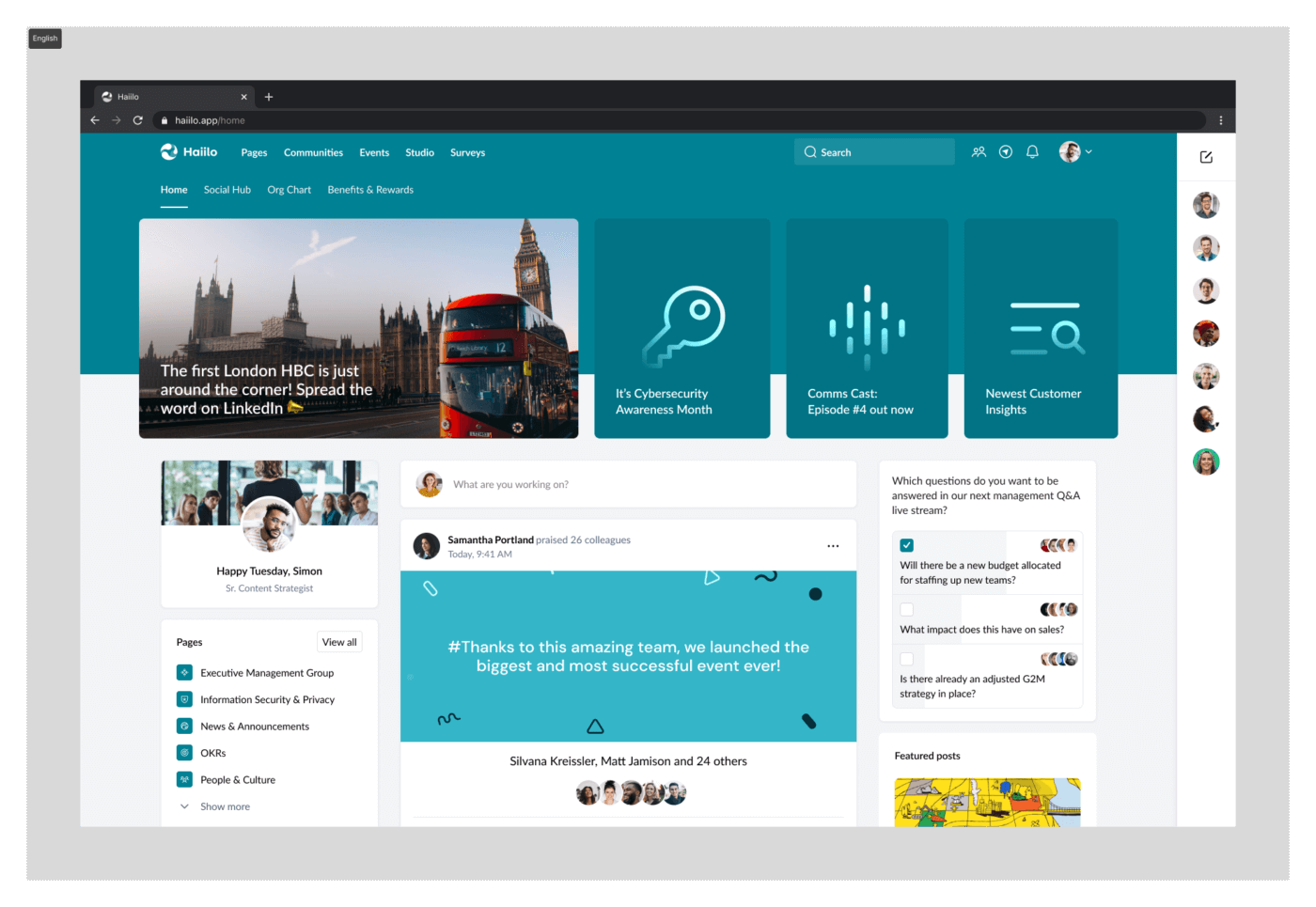
Next, move on to your audiences. Connect your employee personas and their preferences with all the features and add-ons that can help convey your message to them. Don’t worry if the list gets too extensive; later, you might notice that one feature can solve two or three problems at once. At this stage, the objective is to map out the perfect intranet solution.
Assess the tools that are currently in use by the IC department. Compare these tools with your vision for the future intranet, drawing on past experiences to distinguish what works, what doesn’t, and what needs to be improved.
Once your list is complete, you can cluster the features into “must-have” and “good-to-have” categories. These are your guidelines for choosing your future software.
Decide whether you want to build or buy an intranet
The next step is deciding whether you want to build the intranet or buy an out-of-the-box solution.
Usually, when talking about building an intranet, people refer to building on top of Sharepoint. In the meanwhile, buying refers to choosing one of the existing intranet solutions on the market with pre-set features.
There are pros and cons to both approaches, and the solution depends on your particular situation. Generally speaking, building the intranet gives more versatility but can turn out to be more expensive and time-consuming as it depends heavily on IT support.

On the other hand, buying software with pre-set features, while might seem limiting, will most likely end up to be the most efficient (and cost-effective) solution. It doesn’t require much, if any, IT support as all of them are designed to be used out-of-the-box. When chosen carefully, the set of features the intranet software has to offer will match or even exceed your requirements.
📚Learn more: Should You Build or Buy an Intranet? Everything You Need to Know
Get some demos and create a short-list
When you’ve decided on the set of features your new intranet should have, you can go to G2 or Capterra and look for the best providers that meet your expectations. Make sure to filter the results by market segment, as not all intranet providers are equally good for companies of all sizes.
Some other helpful resources to help you with research are ClearBox and SoftwareReviews reports. The former focuses purely on the functionality of intranet software, while the latter takes into consideration the customer experience and the relations providers build with their customers.
Now you’re ready to create your short-list. Schedule a demo with your favorite providers, prepare the questions you’d like to ask, as well as your budget estimate. A good thing to pay attention to is how well the intranet provider is taking care of security. This detail doesn’t have to be limited to GDPR and ISO certification but could also include questions about information security training at the company of a chosen provider.
Don’t be shy! Ask as many questions as you need in order to make your decision.
Get the team’s buy-in
It’s crucial to identify the stakeholders who will have an effect on the project and address their concerns from the get-go. People from HR and IC departments will probably want to know more about the functionality of the intranet and how it will affect their daily business; IT and security teams will be interested in implementation, while the C-level will want to look at cost efficiency and how the new software will save or bring money. Use the information you already have on your hands to justify your choice.
When addressing senior leadership, it’s good to put together some estimates of how the new software will affect the company’s bottom line. If you’re struggling with sourcing the numbers, you can also draw on your previous experience with the current provider to underscore the necessity of change or use the success stories of your chosen vendors to emphasize the influence the intranet has on business.
Finally, establish metrics to track the success of the intranet software implementation, such as user engagement, productivity improvements, and cost savings. Use this data to iterate and make improvements as needed, ensuring the long-term success of the new system.
💡Read on: Looking for the Story Behind the Numbers
Sign the contract. Drive adoption
Now that you’ve got that final approval, it’s time to proceed with the purchase and implementation. Depending on your internal resources, you might want to consider getting onboarding and extensive customer support as part of your package.
Remember to communicate the timeline and tasks with respective stakeholders. You might even want to run simple internal marketing campaigns to create some buzz around the launch of your new intranet. After all, the more your employees are excited about the tool, the more engaged they will be once it’s out there.
The Benefits of Having the Best Intranet Software
Intranet software is one of the key technologies in the workplace, and as such, its benefits range widely from improving productivity and employee satisfaction to increasing safety in the workplace.
Improved knowledge management
Probably the most noticeable benefit of having the right intranet software for your company is streamlined knowledge management. According to McKinsey, an employee spends roughly 2 hours per day searching for information. That’s a lot of wasted productivity. Not to mention that having to search for task-relevant information decreases the ability to focus and, therefore, influences the outcome.
When employees love using the intranet, they will be proactive in sharing important information with their colleagues. Having necessary information available at hand will not only increase employees’ productivity but will also decrease the levels of work-related stress, positively affecting their well-being.
Easier onboarding
This is a natural outcome of the previous point. The right intranet software will serve as a single source of truth, which will make onboarding easier, saving your company time and valuable resources on getting new hires up to speed.
Eliminates cross-departmental silos
More than half of the companies suffer from the consequences of siloed communication. Intranet software improves information workflow and, therefore, decreases the possibility of communication siloes. Employees also get better visibility into other departments, which has a positive influence on increasing transparency and a sense of belonging.

Strengthens employee communities
As discussed in previous articles, employee communities are one of the best ways to increase employee engagement and create an emotional connection between employees and the business. And the best news is that building employee communities doesn’t have to be limited to physical spaces.
Many modern intranet solutions provide community-building features, such as social reactions and the possibility to create your own interest-based pages. When employees have the option to share their opinions, when they feel like their input matters, and, in fact, they can share their expertise, they develop a true sense of belonging, which translates into higher levels of engagement.
Increased strategy comprehension
According to Harvard Business Review, as much as 95% of employees report not understanding the company strategy. Unsurprisingly, this number translates into low employee morale and inevitably leads to poor business performance. On the other hand, when employees know what is expected of them and are aligned around the same purpose, they are more likely to go above and beyond to achieve this goal.
Intranet software enables IC professionals to keep clear and streamlined communications around company goals. They can regularly revisit the workforce sentiment around understanding the company’s purpose by leveraging employee listening tools and send relevant communications to the right audiences at the right time.
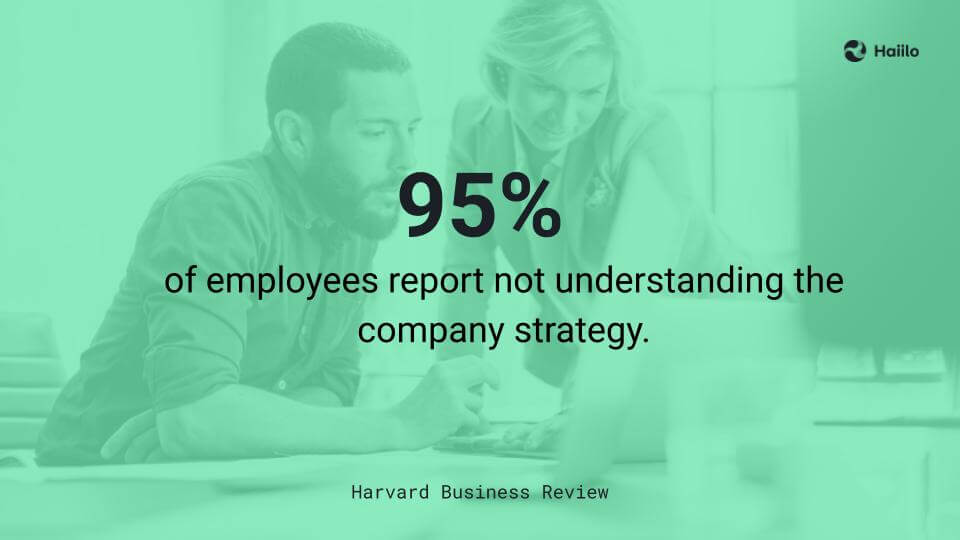
Increased trust in leadership
Trust is fast becoming one of the most important metrics of a successful business. And it’s no surprise since when the trust in leadership (and, by extension, in the company) is low, employees start looking elsewhere and ultimately quit their jobs. The research shows that trust leads to 50% higher productivity and 106% more energy at work.
Having the right intranet software enables leaders to address their employees’ worries and explain the thought process behind this or that decision. The lack of time constraints on virtual communication prompts leaders to share their thoughts more often, which inevitably leads to higher levels of trust among employees.
Increased data security
Having your data and other documents scattered around different tools with vague permission roles is a sure way to a security threat. Using the intranet as a single data point to share all the information is of paramount importance to data security. Most of the modern intranet solutions are GDPR and ISO-certified and require two-factor authentication, which ensures your data is safe.
13 Best Intranet Software Tools in 2025
Of course, this article won’t be complete without a list of the best intranet software providers on the market. Here are the top customer picks in the internal communications and intranet categories:
- Haiilo
- Lumapps
- Happeo
- Staffbase
- Workvivo
- Firstapp
- Unily
- Interact
- Igloo
- Blink
- Jostle
- MangoApps
- Simpplr
1. Haiilo
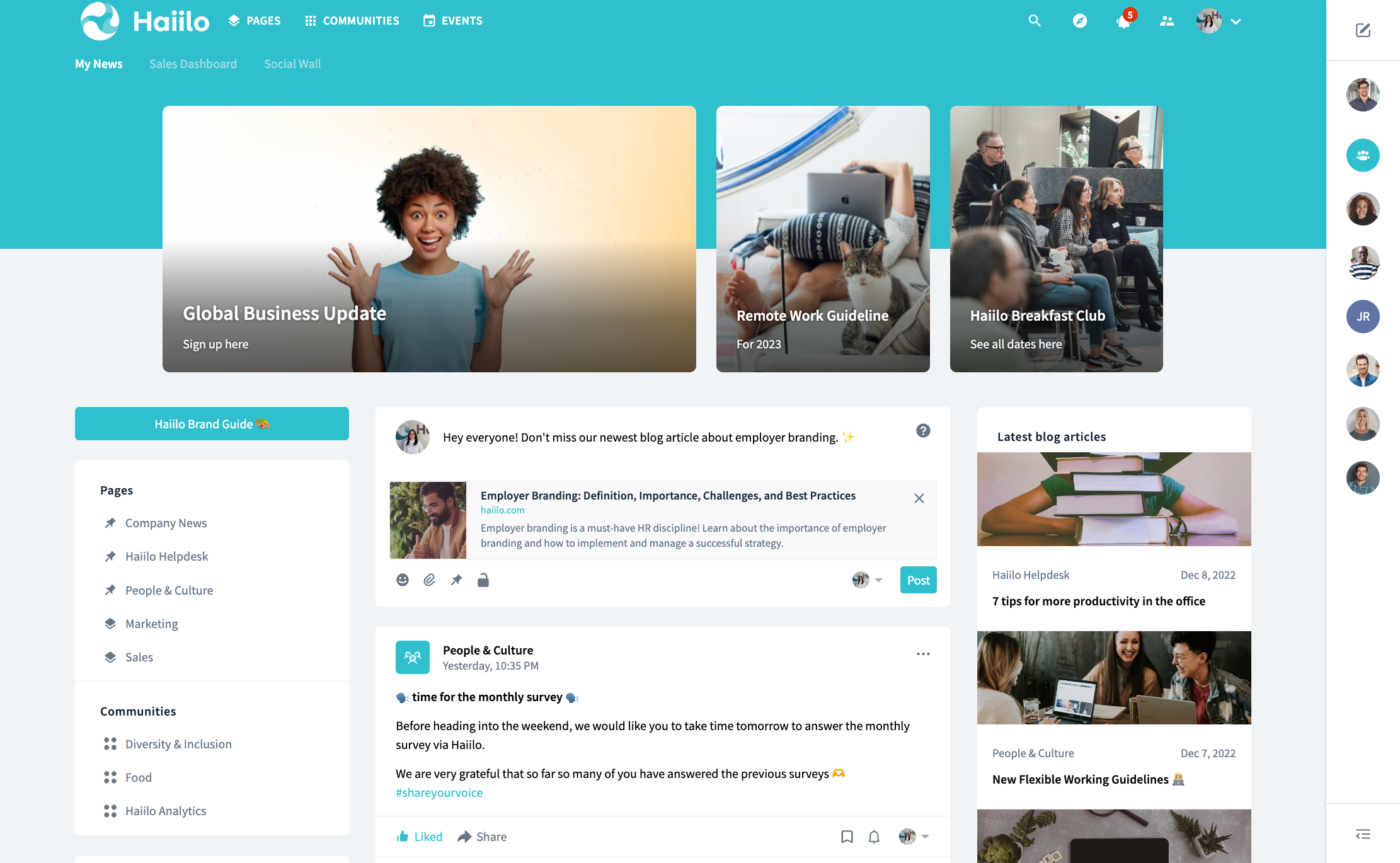
Reviews: 4.6 / 5 stars on G2
Use case: improve employee experience, improve communication in geographicaly distributed with a mixed-collar workforce, increase a sense of belonging in the organization
Target market: 49% Large / 42% Mid-Market
Pros: strong social features, user-friendly interface, no CMS approach, customization, impact analytics
Cons: no pre-existing templates for pages
Pricing: Haiilo offers three pricing pages, Core, Business, and Enterprise. Learn more here.
2. Lumapps
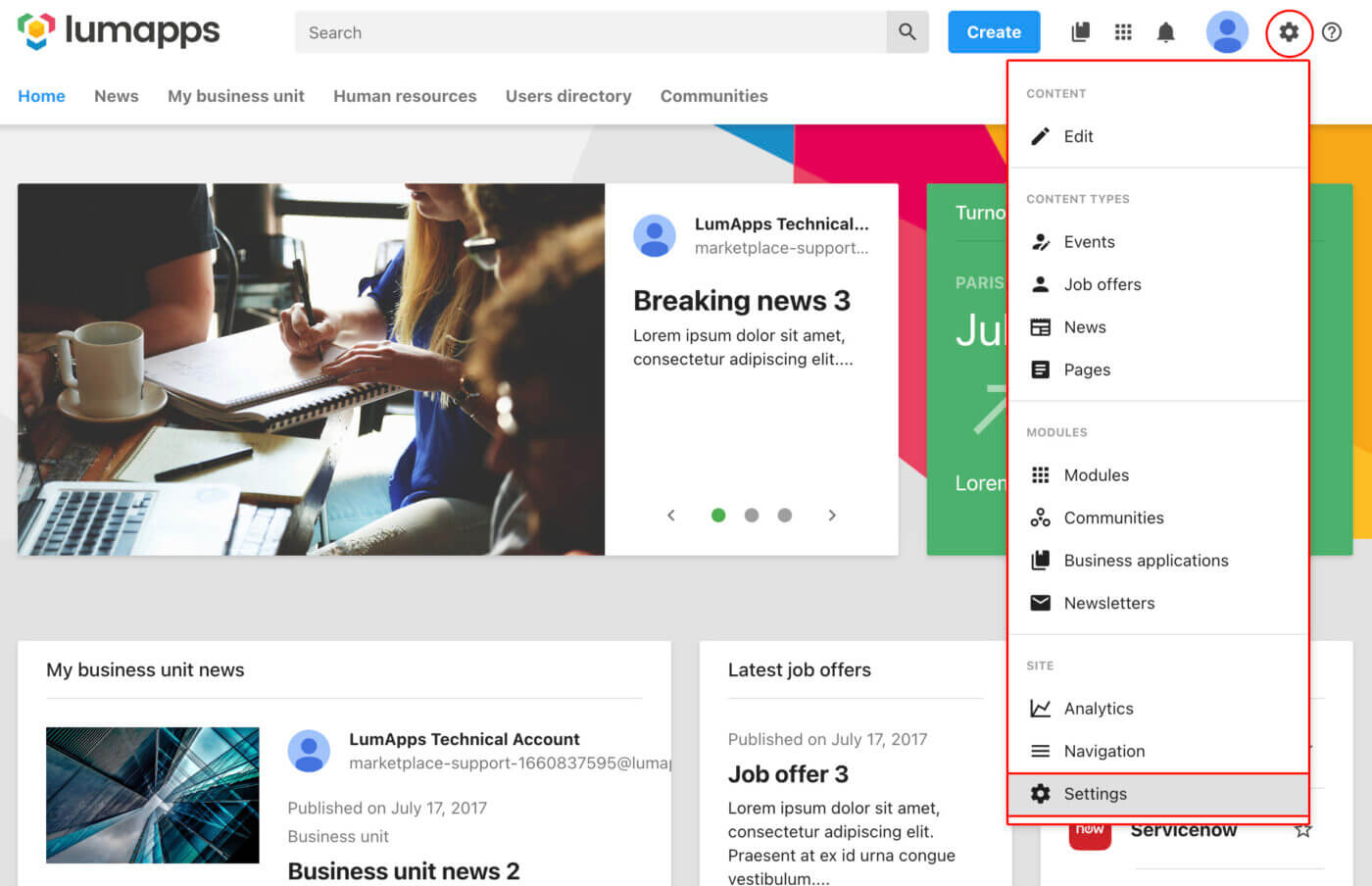
Reviews: 4.2 / 5 stars on G2
Use case: improve knowledge sharing, engage mixed-collar employees in large and enterprise companies
Target market: 65.5% Enterprise / 35.5% Large
Pros: strong customization, many native integrations, including integrations with Google Workspace and Microsoft 365
Cons: IT-heavy implementation
Pricing: Available per request
3. Happeo
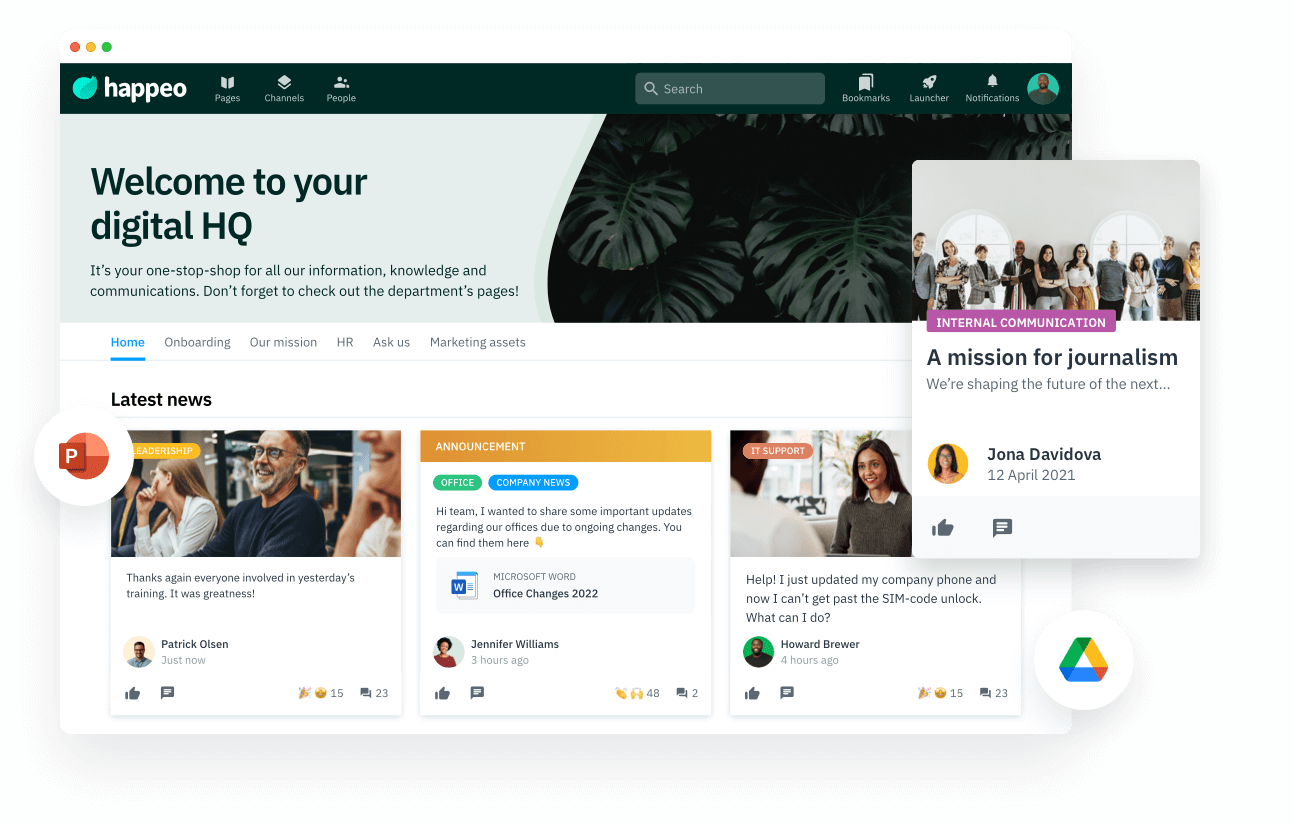
Reviews: 4.5 / 5 stars on G2
Use case: improve social networking and collaboration within a company and democratize content creation in medium-sized companies
Target market: 17.6% Large / 69.7% Mid-Market / 12.7% Small
Pros: powerful federated search, in-depth integration with Google Workspace, personalized notification preferences
Cons: lack of analytics, a mobile app is not on par with the desktop version
Pricing: Available per request
4. Staffbase
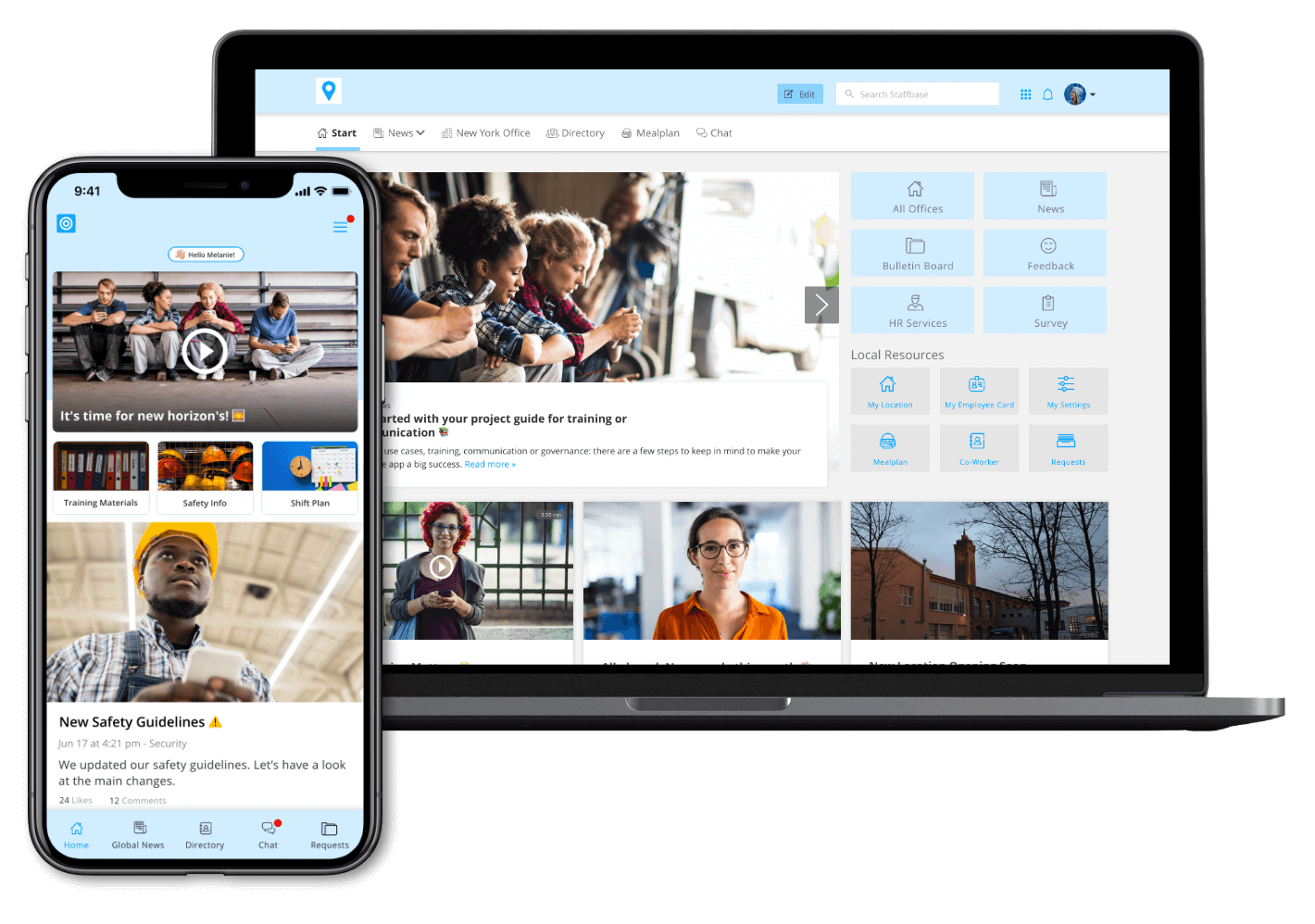
Reviews: 4.6 / 5 stars on G2
Use case: centralize top-down communication, engage frontline workers in geographically dispersed teams
Target market: 58.9% Large / 41.1% Mid-Market
Pros: strong content creation and distribution features, easy-to-use mobile app, white labeling
Cons: limited bottom-up and vertical communications capabilities, limited analytics capabilities
Pricing: Available per request
5. Workvivo

Reviews: 4.8 / 5 on G2
Use case: improve employee experience, improve social networking and collaboration within an organization
Target market: 53.6% Large / 46.4% Mid-Market
Pros: strong integrations, ease of use, strong content creation features
Cons: mobile compatibility, slow performance
Pricing: Business Plan with 250-2000 employees (min pricing starts at $20,000); Enterprise plan with 2000+ employees – contact sales for detailed custom pricing.
6. Firstup
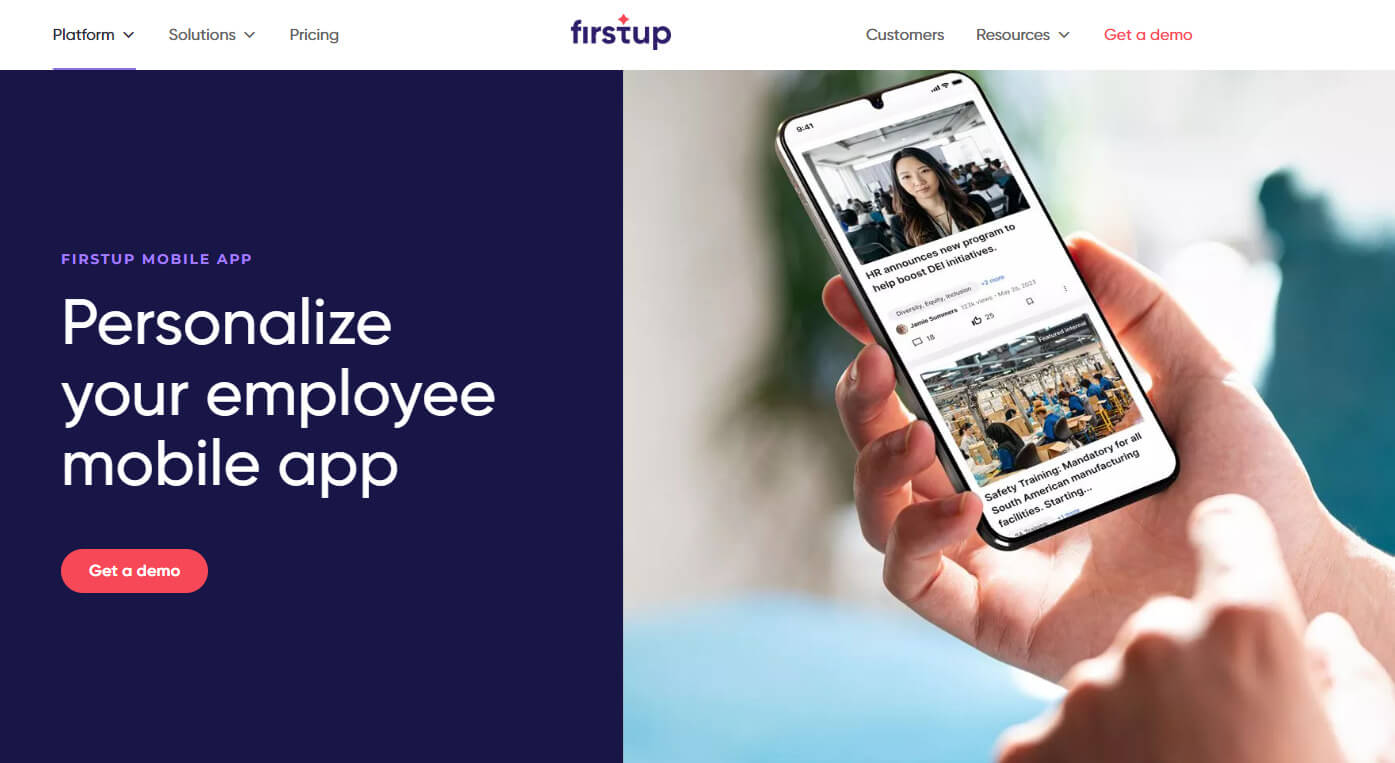
Reviews: 4.6 / 5 on G2
Use case: improve employee productivity and retention in large companies, streamline top-down communications
Target market: 74.7% Large / 25.3% Mid-Market
Pros: multi-channel features, extensive native integrations, strong analytics
Cons: requires a well-defined execution strategy
Pricing: Available per request
7. Unily
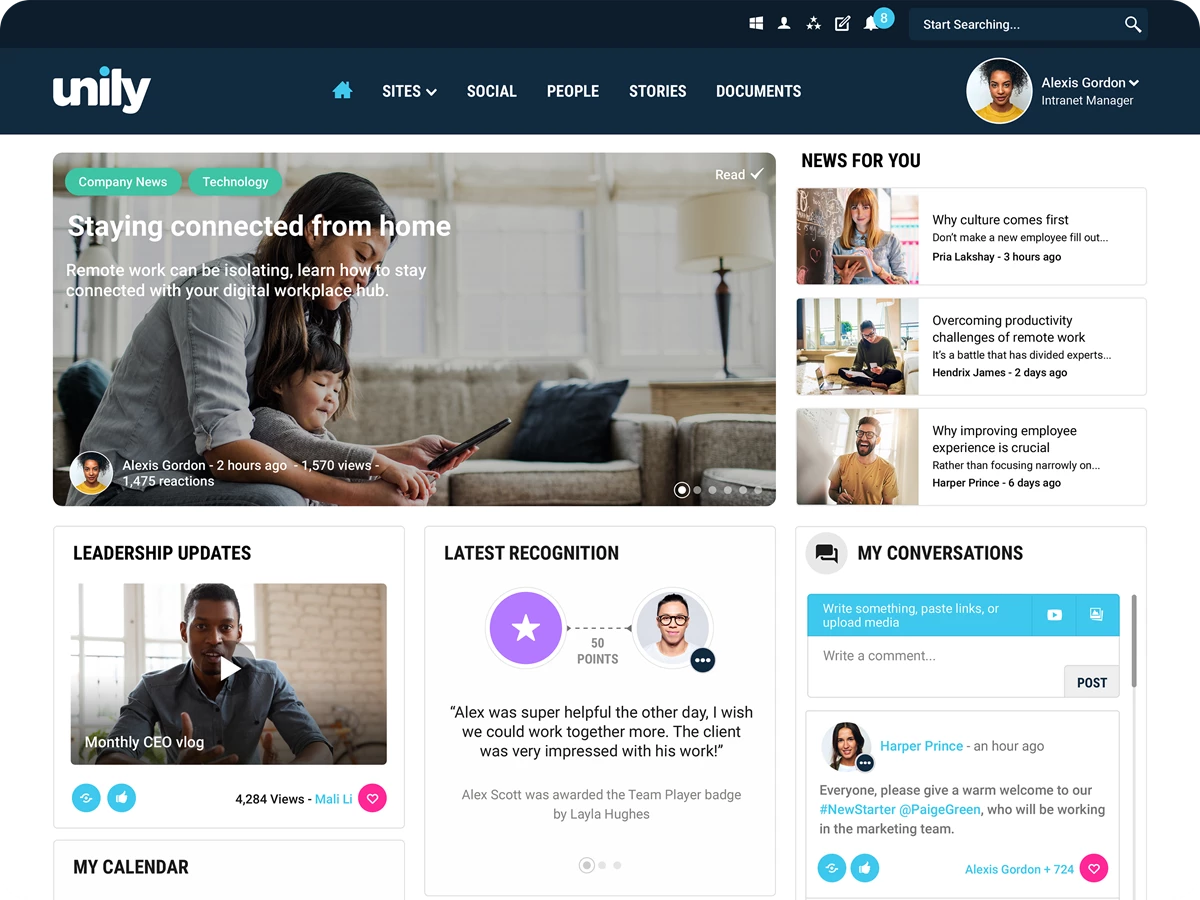
Reviews: 4.5 / 5 stars on G2
Use case: gamify employee experience, engage frontline workers, improve employee recognition in enterprise companies
Target market: 40.5% Enterprise / 35% Large / 24.5% Mid-Market
Pros: feature store, gamification features, native mobile apps for iOS and Android
Cons: some features are underdeveloped, customer support needs to be improved
Pricing: Available per request
8. Interact
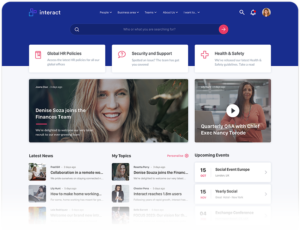
Reviews: 4.6 / 5 stars on G2
Use case: streamline information flow and social networking in large to enterprise companies with complex structures
Target market: 48% Enterprise / 52% Large
Pros: personalized homepages, strong multi-channel features, powerful content editor
Cons: not user-friendly (steep learning curve), limited analytics
Pricing: Available per request
9. Igloo
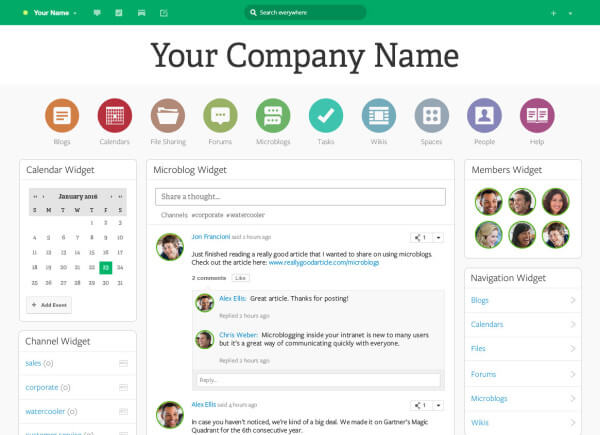
Reviews: 4.2 / 5 stars on G2
Use case: improve information sharing and collaboration in privacy-conscious medium-sized organizations
Target market: 28.4% Large / 56.8% Mid-Market / 14.8% Small
Pros: granular user roles, easy-to-use content editor, strong native integrations
Cons: not user-friendly (steep learning curve), the search function can be improved
Pricing: Available per request
10. Blink

Reviews: 4.7 / 5 stars on G2
Use case: reach mobile workforce with updates, engage frontline workers in large teams
Target market: 52.7% Enterprise / 47.3% Mid-Market
Pros: simple yet effective communication cascading, strong mobile version
Cons: focused heavily on frontline workers and might lack other relevant features
Pricing: Available per request
11. Jostle
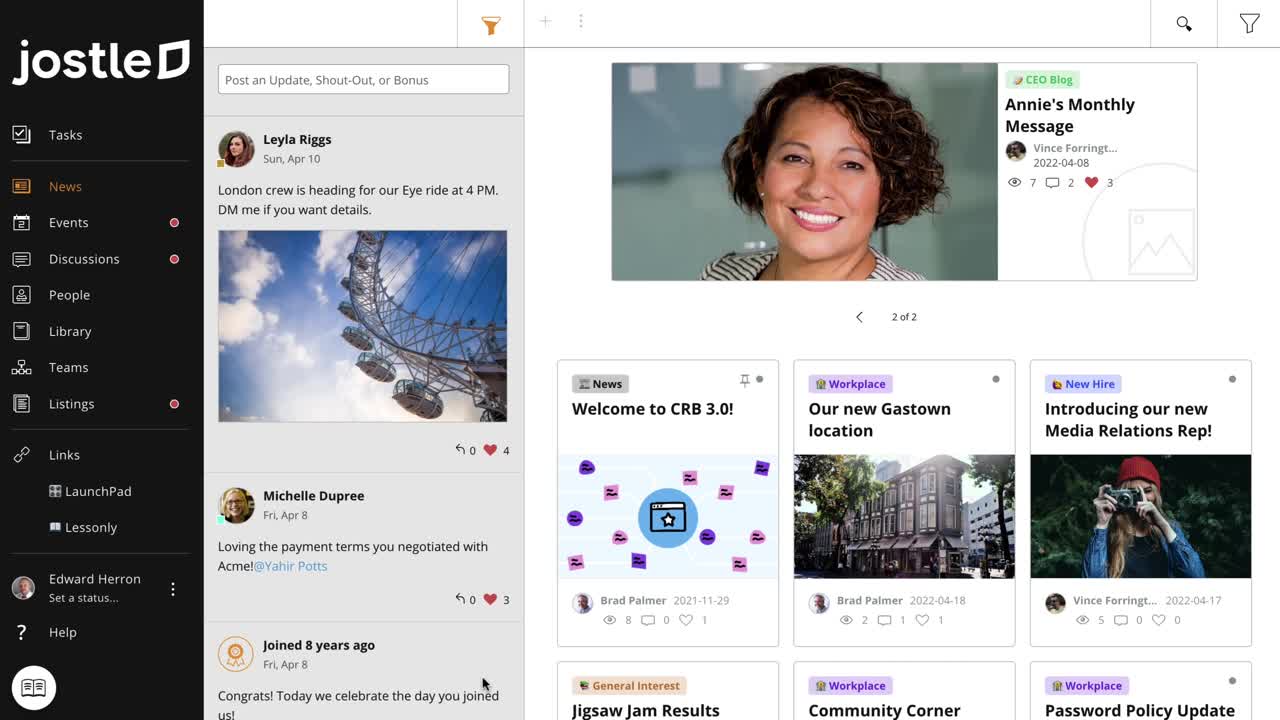
Reviews: 4.5 / 5 stars on G2
Use case: streamline internal communications, improve employee recognition in medium-sized companies
Target market: 21.9% Large / 78.1% Mid-Market
Pros: strong employee profile features, recognition features
Cons: focused exclusively on desk workers, limited mobile capabilities
Pricing: Available per request
12. MangoApps
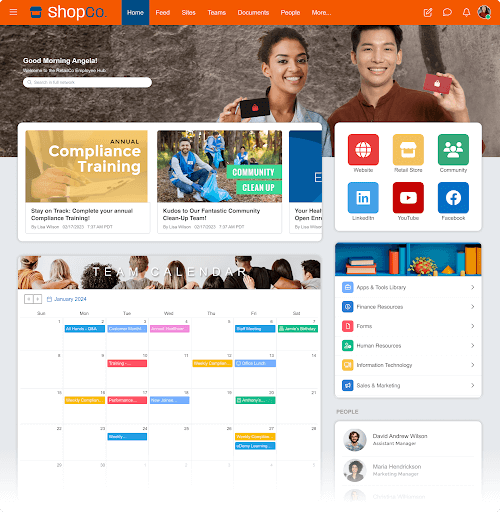
Reviews: 4.2 / 5 stars on G2
Use case: improve teamwork and employee experience in medium-sized companies
Target market: 43.4% Large / 57.6% Mid-Market
Pros: strong content creation and distribution features, user-friendly interface
Cons: limited integrations, steep learning curve
Pricing: Available per request
13. Simpplr

Reviews: 4.7 / 5 on G2
Use case: improve employee experience and productivity with AI-powered internal communications in large to enterprise companies
Target market: 55.6% Large / 44.4% Enterprise
Pros: strong AI features, robust security for managing corporate content, customizable interface
Cons: limited integrations, no lifestreaming or chat group features, limited social features
Pricing: Available per request
We’ve also published an extensive guide on how different intranet providers stack against each other, their strengths and weaknesses, alongside customer quotes. If you want to learn more in detail about different solutions, click here.
Alternatively, you might want to look into other product categories that will be a better fit for your needs. Here’s some further reading to help you in your search process:
Intranet Software FAQ
-
What is intranet software?
-
What are the key features of intranet software?
-
Why do companies use intranet software?
-
How does intranet software improve employee engagement?
-
How can companies ensure their intranet is user-friendly?









